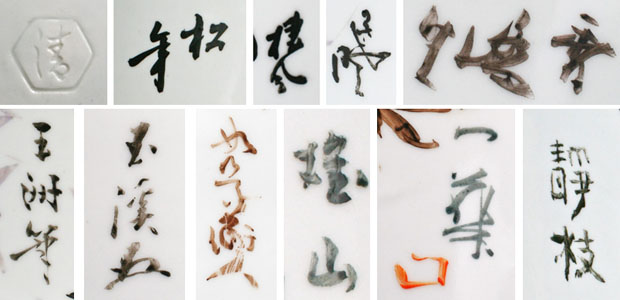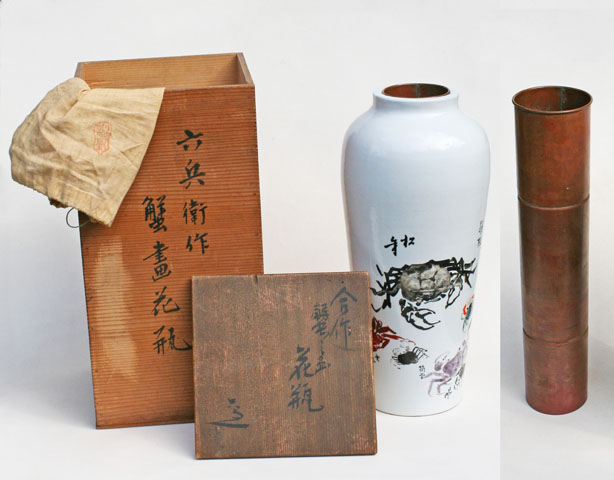Shijô
Hanaire, flower vase, decorated with ten crabs by ten different painters and a poemSigned:
Seals: Kiyo
Technique: Sometsuke, white porcelain with overglaze paintings, with a fitting copper innervase Ø 16.5 x 37.5
Date: c. 1897-1898
Box: signed by Rokubei with sealed shifuku
Condition: old hairline in the glaze, otherwise good
A Gassaku is a collaborative work that can take many forms. It can be a single hanging scroll painting, a hand scroll, an album or even a screen executed by two or more artists, and like most pottery in this catalogue, ceramic works too.
Social events like New Year parties, or parties organized by patrons, as well as the cultural literary gatherings, memorial services and exhibitions all provided good opportunities for artists to affirm shared ideals and to exchange paintings and calligraphy
At the end of a party, a gathering, an exhibition or any other appropriate occasion, the artists present might decide to produce a work together. The result should be an artistic ’epilogue’ to the gathering, which would be left as a memento of the event.
Poem by Shizue:
For only one night I ate rice gruel with the monks
This morning, though, in defiance of every rule
I moved drunkenly into the new autumn.
The inscription resembles a line from the poem Buying fish by the Song-poet Lu You (1125-1210)
Rokubei IV (1847-1920)(Shôrin) was the first son of Rokubei III (Shôun). He studied painting with Shiokawa Bunrin (1801-1877). After his father’s death he inherited the family title in 1883. He was a close friend of Tomioka Tessai (1836-1924) and of Kôno Bairei (1844-1895). Rokubei IV was a great promoter of kyôyaki and already in 1884 he established the Ceramics Commercial and Industrial Association. He actively studied design and participated in the Yûtôen, organized by Asai Chû (1856-1907) and in the Kabikai, presided over by Kamisaka Sekka (1866-1942).
In 1913 he retired due to poor health, transferring the title of the family to his second son Kuritarô, who became Rokubei V (Shôrei) (1875-1959). He then took the artist’s name Rokkyo. The style of Rokubei IV is quiet and elegant, reflecting his own refined character. His works are considered the best among all the works of the succeeding Rokubei generations.
Reference:
Kyoto 2003 (Sekka) p. 326
Suzuki Shônen (1849-1918)
Shônen’s life-style is reflected in his paintings: bold and full of self-confidence.
He was the son and pupil of the Kyoto Shijô artist Suzuki Hyakunen (1825-1891). At a very early age he already achieved great skill and worked in a spontaneous, bold and impromptu manner. In 1881 he succeeded Kôno Bairei (1844-1895) at the Kyôto Art Academy, teaching Northern Chinese painting, where he taught until 1888. In 1886 he also started teaching at the Kyôto Prefectural School of painting, the same school he attended as a pupil. In his later years Shônen was an extremely influential person in Kyoto art circles, with many important patrons.
Reference:
Morioka & Berry ‘99 p. 106-111
Morioka & Berry ‘08 (# 69)
Aburai. p. 218
Roberts p. 167
Araki p. 2792
Takeuchi Seihô (1864-1942)
Seihô was one of the last very important and famous Maruyama-Shijô style painters.
He was an extremely skilful painter, which earned him fame and a lot of pupils. He entered Bairei's studio at the age of 16 and already in the following year he won his first prize at an exhibition, which is a rare for such a young artist.
He eagerly studied all different styles. In 1900 he went to Europe for six months to get acquainted with western painting. On his return he changed the first character "Sei" of his name into a character meaning "West". His two trips to China in 1920 and 1921 meant another enrichment to his painting. His flexibility in styles and the flamboyantly virtuoso way he handled his brush meant in the eyes of some critics that his craftsmanship reduced his artistic abilities.
Reference:
Next to a number of monographs and in any general book on modern Japanese painting:
Harada 1981
Berry & Morioka ‘99 pp. 130-137
Conant pp. 322-323
Roberts p. 171
Araki p. 1633
Takatani Kandô (born 1855) was a pupil of Konô Bairei (1844-1895). He exhibited with the Tokyo Bijutsu.
Reference:
Araki p. 2682
Mochizuke Gyokkei (1874-1938) was the son and pupil of Mochizuki Gyokusen (1834-1913).
Reference:
Aburai p. 382
Fujii Gyokushû (born 1863) was the son of Fujii Shûgyoku (dates unknown) and a pupil of Mochizuki Gyokusen, known as a fine painter of kachôga, bird and flower painting. He was a member of the Kyoto Commitee for the Japan Youth Exhibition.
Reference:
Araki p. 414
Tanaka Ikka (1864-1924) graduated from the Kyoto Prefectural School of Painting and studied with Kubota Beisen (1852-1906). When he was only 18 years old, the Imperial Household Agency bought one of his paintings. He was an active member of several painting associations.
Reference:
Aburai p. 241
Araki p. 20
Mitchell p. 72
The names of the four remaining painters remain unread.
Price: ON REQUEST

